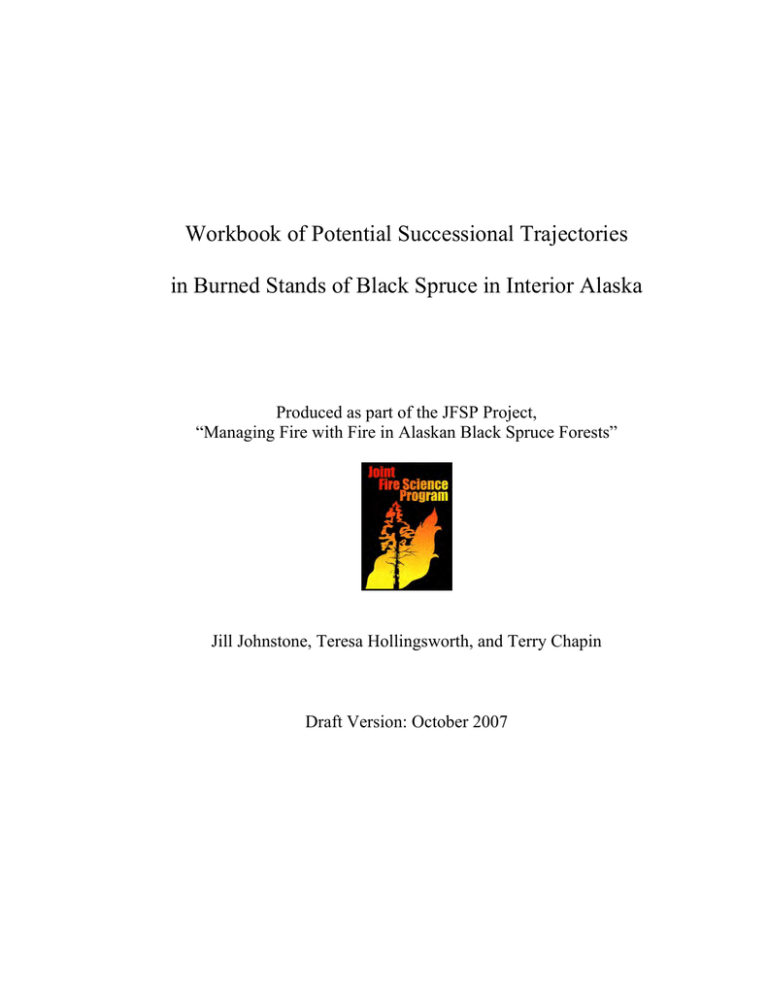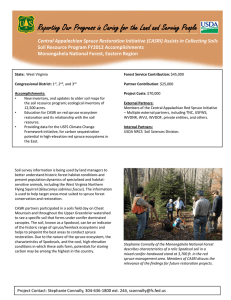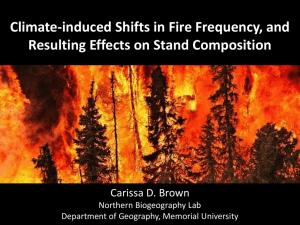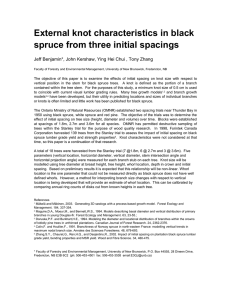Workbook of Potential Successional Trajectories
advertisement

Workbook of Potential Successional Trajectories in Burned Stands of Black Spruce in Interior Alaska Produced as part of the JFSP Project, “Managing Fire with Fire in Alaskan Black Spruce Forests” Jill Johnstone, Teresa Hollingsworth, and Terry Chapin Draft Version: October 2007 Part I: Defining Site Moisture For the purpose of this workbook, site moisture can be defined as the POTENTIAL moisture available for plant growth. Our classification of site moisture is primarily based on the topographic drainage at a given site. We then modify our initial classification based on factors that control drainage within the soil (permafrost and soil texture). Therefore, a sloping site on fine-textured soils with shallow permafrost might have a similar SITE MOISTURE as a flat site with coarse, sandy soils or no permafrost. Our classification system is based on the topographic system of Komárková (1983), and on work by J. Harden and K. Maines at the USGS (unpublished) describing site drainage classification in interior Alaska. We have developed a series of steps for classifying site moisture that are described in text, below, and as a pictograph in Figure 1. STEP 1: Determine the site moisture based on topography (modified from Komárková 1983). Dry sites: Xeric - Little surface moisture; stabilized sand dunes and dry ridge tops Subxeric – Some noticeable surface moisture; well-drained slopes or ridges Subxeric to mesic - Very noticeable surface moisture; flat to gently sloping Moist sites: Mesic - Moderate surface moisture; flat or shallow depression, including toe-slopes Mesic to subhygric - Considerable surface moisture; depressions or concave toe-slopes Subhygric - Very considerable surface moisture; Soil is saturated but < 5% of the surface is standing water STEP 2: Does the site have extensive shallow permafrost? If yes, then site becomes one classification wetter. For example if a site, based on topography, is classified as subxeric to mesic, it would be reclassified as mesic. Our operational definition of shallow permafrost is a site where the maximum depth of thaw is less than 75 cm below the soil surface. The presence of shallow permafrost inhibits soil drainage by creating a water-impermeable layer near the soil surface. STEP 3: What is the soil texture of the site? If the soil is very coarse in texture, then the site becomes one classification drier. For example, if the topographic classification is “subxeric to mesic” and the soils are very coarse, the site would be reclassified as “subxeric”. We define coarse-textured soils as those dominated by sand or gravel in at least the upper 50 cm of the soil profile. Coarse soil texture tends to increase soil drainage and decrease site moisture by allowing surface moisture to rapidly drain to deeper soil layers. Figure 1: Pictographic key to classifying the potential site moisture of black spruce stands in interior Alaska. Part II. Factors that predict the potential for black spruce stands to shift in successional trajectories following fires Background: In most situations, we expect black spruce forests to regenerate after fire to a stand composition and density that is similar to the pre-fire community. There are two factors that appear to be particularly important in supporting stand self-replacement as the dominant successional pattern in Alaskan black spruce forests. These are: a. The formation of a moss- or lichen-dominated understory that leads to the accumulation of thick (>10 cm) organic layers at the soil surface; and the poor combustion of those layers during a fire, leading to a postfire seedbed that is dominated by organic substrates. b. The development of aerial seedbanks that are held in the semi-serotinous cones of black spruce, leading to a large supply of on-site seed for black spruce after fire. Thick, post-fire organic seedbeds are typically porous and subject to rapid drying, and generally form poor-quality seedbeds for the establishment of tree seedlings. However, black spruce can partially overcome this limitation by producing abundant seed after fire from an aerial seed bank held in serotinous cones. Thus, even though the success rate of seedling establishment is low, black spruce trees are able to compensate by having a strong local seed source that provides lots of seed. This large number of seeds increases the likelihood that some seeds will land into suitable microsites for germination and growth. Consequently, the combination of organic seedbeds and an aerial seedbank gives black spruce a strong advantage in regenerating in sites after fire. Some potentially co-habitating species, such as birch or aspen, have well-distributed seeds but also very small seed sizes. These small seeds have fewer reserves to support early seedling root growth, and consequently have a particularly poor ability to successfully establish on porous organic seedbeds. Other Alaskan conifers, such as white spruce, have seeds that are similar in size to those of black spruce, but lack the serotinous seed habit that provides a large supply of on-site seed. Nevertheless, exceptions to the general pattern of black spruce self-replacement after fire do occur, and these may be widespread under certain conditions. The potential to initiate stands with alternative successional trajectories is largely driven by interactions between the pre-fire vegetation composition, site conditions, and fire effects on the reproductive potential of alternate dominant species. Below, we list the scenarios likely to result in black spruce stands transitioning to an alternative successional trajectory following fire. This is not an exhaustive list, but represents the most likely scenarios of change based on our current understanding of successional processes in black spruce forests of interior Alaska. Key to conditions that favor the formation of alternative successional trajectories in black spruce forests after fire: 1. Substantial combustion of the surface organic layers leads to exposed mineral soil or deep humic layers. These seedbeds provide a more stable moisture supply to support seedling recruitment. Deciduous trees can invade by seed, even at sites many km distant from live seed sources. a. Deciduous invasion on post-fire humic layers or moist organic soil is expected to lead to deciduous trees that grow relatively slowly and do not strongly impact the recruitment of understory spruce. Post-fire succession will have an increased deciduous component, but the deciduous phase may functionally resemble the willow-dominated phases of spruce self-replacement. b. Deciduous tree growth and productivity is expected to be highest at sites with widespread exposure of mineral soil (>30%) or very shallow organics (<3 cm). Where deciduous species invade and grow rapidly, successful recruitment of black spruce may be reduced. Post-fire succession is likely to lead to a prolonged deciduous-dominated phase (lasting on the order of 50-80 years post-fire) that succeeds to low-density, mature black spruce in later stages. 2. Deciduous tree species are present in the pre-fire stand. When present and abundant (>5 stems/0.1 ha plot for aspen, >20 stems/0.1 ha plot for birch), aspen and birch are able to asexually regenerate after fire and give rise to a rapidly growing, early deciduous phase. Rapid growth and abundant litter production may reduce the potential for spruce establishment at well-drained sites. Post-fire succession is likely to lead to a prolonged deciduous-dominated phase (lasting on the order of 60-90 years post-fire) with succession to low-density, mature black spruce in later stages. 3. Adjacent stands of unburned white spruce provide a strong source of white spruce seed into the burned black spruce stand. Where white spruce seed is abundant, it can recruit on organic surfaces at a level similar to black spruce. White spruce seed availability will be highest where burned stands are adjacent to live white spruce stands, or when a late-season fire allows for the dispersal of viable seed from burned white spruce. In both cases, spatial proximity to a white spruce seed source is a major factor determining whether white spruce can become co-dominant with black spruce in the post-fire stand. 4. Local seed for black spruce is reduced by fire effects (trees fallen, cones burned, cones not open, or young trees burned after a short fire interval). Because all of these factors reduce the availability or dispersal of black spruce seeds from an aerial seed bank, they reduce the potential for black spruce regeneration. In these cases, post-fire succession will have reduced black spruce density. a. If post-fire seedbeds are dominated by organic soils, succession will proceed to a prolonged shrub- or graminoid-dominated phase with the eventual development of a very open canopy of black spruce. b. If post-fire seedbeds are dominated by mineral soils, deciduous species are likely to successfully establish and lead to the development of deciduous stands with only a sparse or absent component of understory spruce. Return to black spruce may not occur before the stand burns again. Part III. Dichotomous key to identify potential successional trajectories in recently burned black spruce forest (0-2 years postfire) Initial key: Site factors driving recruitment potential 1. Site is moist (mesic - subhygric) with the upper duff layer largely intact and low exposure of (<5%) humic or mineral soils (photos 1&2). 2. Site is moist (mesic - subhygric) and the organic layer has been severely burned, leading to shallow (<5 cm averaged depth) residual organic layers and at least moderate (> 5%) exposure of humic or mineral soil (photos 3&4). 3. Site is dry (mesic/subxeric – xeric) with an intact organic layer and low (<15%) mineral soil exposure (photos 5&6). 4. Site is dry (mesic/subxeric – xeric) with extensive (>15%) mineral soil exposure (photos 7&8). 1. Moist sites (mesic to subhygric) with post-fire organic layers intact. These sites may experience a range of conifer recruitment, depending on the availability of local conifer seed. Where seed is abundant, wetter sites will have higher densities of conifer seedlings. For deciduous species, the potential for seedling recruitment is generally low on thick organic layers. If deciduous trees were present in the pre-fire stand, some recruitment may occur through re-sprouting. However, the cool and moist soils are likely to keep the biomass or cover of deciduous trees low in all stages of succession. Consequently, most sites of this type will rapidly return to dominance by black spruce. A. There are multiple standing black spruce trees with open cones at the site providing a strong local seed source. AI. The residual organic layer is thick (>20 cm), with abundant scorched tussocks or sphagnum moss. Thick moss layers may prevent the penetration of seedling roots to a stable moisture supply at sites without freely available moisture. Thick moss also favors cold soil temperatures that are likely to limit seedling growth. The expected successional trajectory is open-canopy black spruce. AII. The residual organic layer is less than 20 cm thick, and is composed primarily of burned or scorched feathermoss rather than sphagnum. Thinner moss layers combined with moist site conditions allow higher rates of black spruce establishment. The expected successional trajectory is intermediate- to closed-canopy black spruce. B. The local seed source for black spruce is limited by most trees having fallen over, trees being too young to bear many cones, or the cones being either deeply charred (severe crown fire) or not open (fire did not crown). Consequently, seedling establishment is likely to be very low, leading to the formation of open canopy black spruce, or spruce-lichen woodland. 2. Moist sites (mesic to subhygric) with shallow surface organic layers or exposed mineral soil. These sites generally have a high recruitment potential for both conifer and deciduous species. The exposed mineral or humic soils have high bulk densities and are able to wick moisture to the soil surface, increasing the germination and survival of conifer and deciduous seedlings. Where there is extensive mineral soil exposure, moss colonization may ‘lock up’ a substrate and limit successful regeneration to only those seeds that arrive immediately after the fire (often deciduous seed). These sites have a range of possible successional trajectories. A. There are multiple standing black spruce trees with open cones at the site that provide a strong on-site seed source for black spruce. AI. Pre-fire aspen or birch trees are present at the site, with intact roots or stumps, or there is a stand of live deciduous trees in the area (within 1-2 km) that can provide a local seed source for deciduous trees. AIa. There is extensive exposure of mineral soil (>30% of surface). AIa-1. Mineral soils are very moist and support rapid colonization by Marchantia (broad-leaved liverwort). Deciduous trees can establish rapidly from seed or resprouting, but seedbed quality rapidly declines and limits black spruce establishment. The expected successional trajectory is closed deciduous forest with a sparse understory of black spruce. AIa-2. Mineral soils are less moist, and support slower colonization by small, single-stemmed mosses such as Ceratadon. Both deciduous trees and black spruce have high potential rates of establishment. The expected successional trajectory is mixed deciduous - black spruce forest AIb. Mineral soil exposure is intermediate (5-30%) or limited to only exposure of humic soil. Deciduous trees are likely to have variable establishment success on the mixed seedbed, while black spruce is expected to be able to establish on all substrate types. The expected successional trajectory is mixed deciduous - black spruce forest. AII. There are few deciduous trees in pre-fire stand or surrounding unburned forest. Deciduous trees have few opportunities to establish from seed or by re-sprouting. The expected successional trajectory is intermediate- to closed-canopy black spruce forest. B. The local seed source for black spruce is limited by most trees having fallen over, trees being too young to bear many cones, or the cones being either deeply charred (severe crown fire) or not open (fire did not crown). BI. There is a stand of live deciduous trees in the area (within 1-2 km) that can provide a local seed source for deciduous trees, and/or pre-fire deciduous stems are common at the site with roots or stumps intact. Deciduous recruitment is likely to be abundant, but low seed availability will limit black spruce establishment. The expected successional trajectory is closed deciduous forest with few to no black spruce in the understory. BII. There are few live deciduous trees in the area and no pre-fire birch or aspen at the site. Recruitment of both deciduous trees and black spruce is likely to be strongly limited by low seed availability. The expected successional trajectory is non-forested shrubland/grassland, or open spruce-lichen woodland. 3. Drier sites (mesic/subxeric to xeric) with post-fire organic layers largely intact. Sites may have moderate recruitment potential for conifers, but deciduous recruitment from seed will be limited by dry conditions at the surface of the intact organic layers. Establishment of deciduous species will be largely limited to asexual regeneration (resprouting). A. There are multiple standing black spruce trees with open cones at the site that provide a strong on-site seed source for black spruce. AI. Pre-fire aspen or birch trees are present at the site, with intact roots or stumps to support asexual regeneration. The expected successional trajectory is closed deciduous forest with intermediate density of understory black spruce. AII. Pre-fire aspen or birch trees are rare or absent from the site. Intact organic layers restrict deciduous colonization from seed. The expected successional trajectory is intermediate density, black spruce forest. B. The local seed source for black spruce is limited by most trees having fallen over, trees being too young to bear many cones, or the cones being deeply charred (severe crown fire). BI. Pre-fire aspen or birch trees are present at the site, with intact roots or stumps to support asexual regeneration. The expected successional trajectory is closed deciduous forest with a sparse or absent understory of black spruce. BII. Pre-fire aspen or birch trees are rare or absent from the site. Intact organic layers restrict deciduous colonization from seed. The expected successional trajectory is nonforested grassland, or open spruce-lichen woodland. 4. Drier sites (mesic/subxeric to xeric) with organic layers largely consumed, leading to exposed mineral soil. These sites have a moderate to high recruitment potential for both conifers and deciduous trees. Conifer recruitment density is likely to be moderate at the driest sites, due to dry surface conditions even where mineral soil is exposed. Recruitment of deciduous species will be affected by the potential for asexual regeneration. These sites also have the potential to support establishment of white spruce if there is a live stand of white spruce close to the site (<1 km). Sites in this category have the highest potential to shift from black spruce to alternate successional trajectories. A. There are multiple standing black spruce trees with open cones at the site that provide a strong on-site seed source for black spruce. AI. Pre-fire aspen or birch trees are present at the site, with intact roots or stumps. Resprouting of deciduous species is likely to be abundant, and high litter production in the early post-fire years may reduce levels of black spruce recruitment. The expected successional trajectory is closed-canopy deciduous forest with an open understory of black spruce. AII. Pre-fire aspen or birch trees are rare or absent from the site. AIIa. There is at least one stand of live deciduous trees in the area (within 1-2 km) that can provide a local seed source for deciduous trees and there is good seed production in the year after the fire. The expected successional trajectory is mixed deciduous – black spruce forest. AIIb. There are few live deciduous trees in the area or bad seed years after fire, resulting in low deciduous recruitment. The stand is likely to develop into intermediate- to closed-canopy black spruce forest. B. The local seed source for black spruce is limited by most trees having fallen over, trees being too young to bear many cones, or the cones being deeply charred (severe crown fire). BI. Pre-fire aspen or birch trees are present at the site, with intact roots or stumps. Resprouting of deciduous species is likely to be abundant, with little recruitment of black spruce. The expected successional trajectory is closed canopy deciduous forest with sparse or absent black spruce. BII. Pre-fire aspen or birch trees are rare or absent from the site. BIIa. There is at least one stand of live deciduous trees in the area (within 1-2 km) that can provide a local seed source for deciduous trees and there is good seed production in the year after the fire. The expected successional trajectory is open canopy deciduous forest with sparse or absent black spruce. BIIb. There are few live deciduous trees in the area or bad seed years after fire. Both conifer and deciduous recruitment is low, leading to open aspen parkland or grassland. Appendix A: Operational Definitions Spatial scale of assessment The key has been designed to assess potential successional trajectories at the scale of individual forest stands. Forest stands can be intuitively defined as a patch of forest that can be visually assessed from a central point (approximately 20-30 m radius around the observer). On an aerial basis, the scale of assessment is expected to be on the order of 0.25 ha, with a reasonable range of 0.1 to 1.0 ha. Classifications of post-fire seedbeds Sites are classified with respect to the availability of different post-fire seedbeds, largely on the basis of the depth and coverage of any remaining surface organic layers. Assays with a shovel or soil corer should be used at a site to estimate the characteristics of the soil organic layer. Stated thresholds in seedbed classifications are based on empirical observations of 2004 burns in Alaska studied as part of the JFSP project. 1. Mineral soil dominated: Seedbeds dominated by more than 30% exposure of mineral soil or shallow organic layers (dense, humic layers <3 cm depth) 2. Organic soil dominated: Seedbeds dominated by cover of low-density organic layers, particularly soils with >5cm organic layer depth and less than 15% mineral soil exposed 3. Intermediate soils: Surface organic soils are of high density, capable of wicking up sub-surface moisture, or with patches of mineral soil exposure between 15-25%. Plant Species (Note: We will be adding photos of the main plant species to the workbook at a later date.) black spruce: Picea mariana Ceratadon: One of the most common types of small, unbranched mosses that colonizes organic and mineral soil after fire. deciduous trees: primarily Populus tremuloides (trembling aspen) and Betula neoalaskana (Alaska paper birch) feathermoss: Pleurocarpous mosses commonly found in later successional stages of black spruce forest, such as Hylacomium splendens and Pleurozium shreberi. Marchantia: A broad-leaved liverwort that is an abundant early colonist after fire of moist to wet mineral soils and exposed humic layers. sphagnum moss: Mosses in the genus Sphagnum, which commonly occur in wet habitats. tussocks: Sedges that form tight clumps (tussocks); predominantly Eriophorum vaginatum. white spruce: Picea glauca Appendix B: Reference Photo Gallery Post-fire site assessment - See photos at the end of this document – These photos were taken in late May in the year after the stands had burned. All sites were dominated by black spruce prior to burning. Sites are taken as examples from the suite of sites selected for study as part of a larger study of post-fire succession in black spruce forests. Site codes indicate the general area of the burn in interior Alaska (BF=Boundary Fire, along the Steese Highway; DC = Dalton Complex, along the Dalton Highway north of the Yukon River; TC = Taylor Complex, along the Taylor Highway between Tok and Chicken). 1. Moist sites with the organic layer largely intact after the fire 2. Moist sites with shallow residual organic layers and frequent patches of exposed humic or mineral soil 3. Dry sites with the organic layer largely intact after the fire 4. Dry sites where much of the organic layer has been consumed by the fire, exposing frequent patches of mineral soil Photo examples of successional trajectories - These photos have yet to be added to the workbook. open-canopy black spruce intermediate- to closed-canopy black spruce spruce-lichen woodland open deciduous forest with sparse or absent black spruce mixed deciduous - black spruce forest closed deciduous forest closed canopy deciduous forest with an open understory of black spruce closed canopy deciduous forest with sparse or absent black spruce. open aspen parkland grassland non-forested shrubland/grassland Moist sites with the organic layer largely intact after the fire Moist sites with shallow residual organics Dry sites with organic layers intact Dry sites with exposed mineral soil




